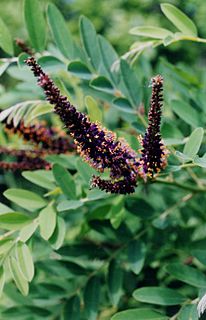
Amorpha is a genus of plants in the pea family, Fabaceae. All the species are native to North America, from southern Canada, most of the United States (US), and northern Mexico. They are commonly known as false indigo. The name Amorpha means "deformed" or "without form" in Greek and was given because flowers of this genus only have one petal, unlike the usual "pea-shaped" flowers of the Faboideae subfamily. Amorpha is missing the wing and keel petals.

Camden State Park is a state park on the Redwood River in southwestern Minnesota near Marshall. It is used for picnics, camping, hiking, and other outdoor recreation.

Amorpha juglandis, the walnut sphinx, is the only species in the monotypic moth genus Amorpha, which is in the family Sphingidae, erected by Jacob Hübner in 1809. The species was first described by James Edward Smith in 1797.

The Field Elm cultivar Ulmus minor 'Sowerbyi', commonly known as the Sowerby Elm, was described by Moss in The Cambridge British Flora (1914). The tree, once referred to as the 'Norfolk Elm' by Smith, was commonly found in the hedgerows and woods of Norfolk, Cambridgeshire, and Huntingdonshire in the early 20th century before the advent of Dutch elm disease. Melville considered it a hybrid of 'Coritana'.

The Field Elm cultivar Ulmus minor 'Pendula' was said to have been raised in Belgium in 1863. It was listed as Ulmus sativa pendula by C. de Vos in 1887, and by Boom in 1959 as a cultivar.

Amorpha californica is a species of flowering plant in the legume family known by the common name California false indigo.
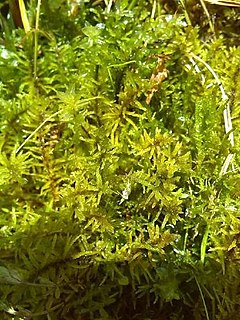
Helodium blandowii, also known as Blandow's helodium moss, Blandow's tamarisk-moss, Blandow's bogmoss, and Blandow's feathermoss, is a rare plant in the Western U.S., including Oregon and California. It occurs all around the northern hemisphere in higher latitudes, and in some places is not as rare as in the Western U.S.
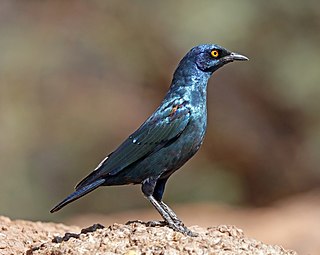
The Cape starling, red-shouldered glossy-starling or Cape glossy starling is a species of starling in the family Sturnidae. It is found in Southern Africa, where it lives in woodlands, bushveld and in suburbs.
In enzymology, an amorpha-4,11-diene synthase (ADS) is an enzyme that catalyzes the chemical reaction

Amorpha fruticosa is a species of flowering plant in the legume family Fabaceae, known by several common names, including desert false indigo, false indigo-bush, and bastard indigobush. It is native to North America.

Zerene cesonia, the southern dogface, is a North and South American butterfly in the family Pieridae, subfamily Coliadinae.

Leptotes cassius, the Cassius blue or tropical striped blue, is a butterfly of the family Lycaenidae. It is found in North America in Florida including the Keys, Texas south through the Caribbean, Mexico, and Central America to South America. Strays have been found in New Mexico, Kansas, Missouri, South Carolina, North Carolina and Virginia.
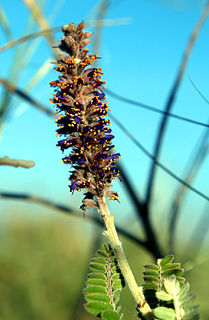
Amorpha canescens, known as leadplant, downy indigo bush, prairie shoestring, or buffalo bellows, is a small, perennial semi-shrub in the pea family (Fabaceae), native to North America. It has very small purple flowers with yellow stamens which are grouped in racemes. Depending on location, the flowers bloom from late June through mid-September. The compound leaves of this plant appear leaden due to their dense hairiness. The roots can grow up to 5 m (16 ft) deep and can spread up to 1 metre radially. This plant can be found growing in well-drained soils of prairies, bluffs, and open woodlands.

Amorpha nana is a 1–3-foot (30–91 cm) tall perennial shrub in the Pea family (Fabaceae) which is native to North America. It has vibrant green pinnate leaves and clusters of purple flowers. The fruits are small pods. Dwarf false indigo grows in dry prairies and rocky hillsides. Amorpha nana likes rocky and sandy soil.

Alexgeorgea is a genus of three plant species found in Western Australia belonging to the family Restionaceae named in honour of the botanist Alex George in 1976. The flowers of the female and large nut-like fruit are completely underground except for the stigmas, which extend out of the ground as 3 purple or red threads.
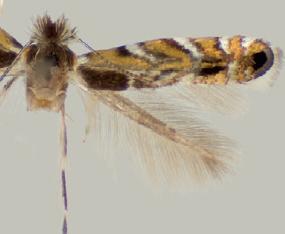
Macrosaccus uhlerella is a moth of the family Gracillariidae. It is known from Illinois, Missouri, New York, Colorado and Texas in the United States.

Amorpha ouachitensis is an uncommon North American species of flowering plant in the legume family known by the common names Ouachita leadplant, Ouachita Mountain leadplant, Ouachita false indigo, and Ouachita indigobush. It is native to Oklahoma and Arkansas in the United States.
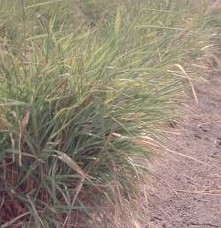
Melica nitens is a species of grass known by the common name threeflower melicgrass. It is native to the central United States.

The Charlton Recreation Area is a public use area of the Ouachita National Forest, located just north of United States Route 270 between Crystal Springs and Mount Ida, Arkansas. The area includes a campground and day use facilities for water-related activities on Walnut Creek, including fishing and swimming. The facilities are organized around a small artificial lake created in 1938 by a crew of the Civilian Conservation Corps by damming the creek. The stone Charlton Dam and Spillway, about 100 feet (30 m) in length, was listed on the National Register of Historic Places 1993, as was the stone Charlton Bathhouse, also built by the CCC in 1938.
The Field Elm cultivar Ulmus minor 'Viminalis Betulaefolia' (:'birch-leaved') is an elm tree of uncertain origin. An U. betulaefolia was listed by Loddiges of Hackney, London, in the catalogue of 1836, an U. campestris var. betulaefolia by Loudon in Arboretum et Fruticetum Britannicum (1838), and an U. betulifoliaBooth by the Lawson nursery of Edinburgh. Henry described an U. campestris var. betulaefolia at Kew in 1913, obtained from Fulham nurseryman Osborne in 1879, as "scarcely different from var. viminalis ". Melville considered the tree so named at Kew a form of his U. × viminalis, while Bean (1988), describing U. 'Betulaefolia', likewise placed it under U. 'Viminalis' as an apparently allied tree. Loudon and Browne had noted that some forms of 'Viminalis' can be mistaken for a variety of birch. An U. campestris betulaefolia was distributed by Hesse's Nurseries, Weener, Germany, in the 1930s.


















